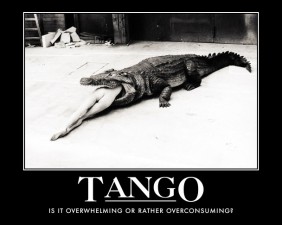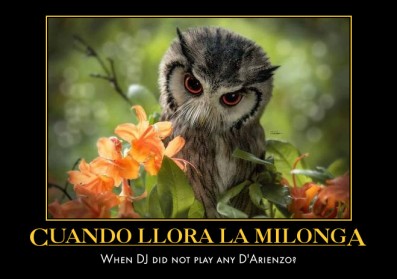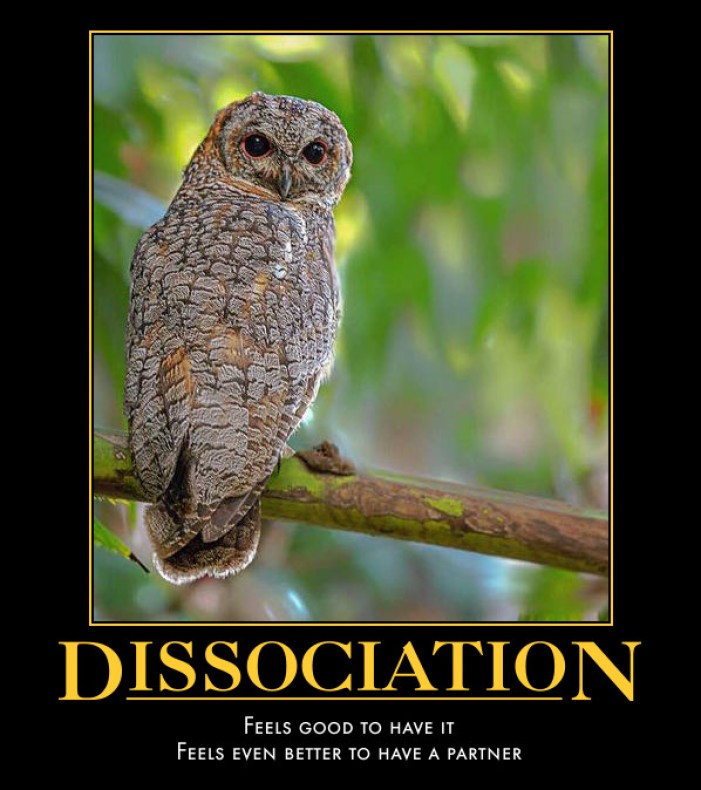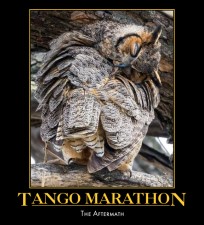Category Archives: tango stories
La puñalada
 In 1943 Juan D’Arienzo recorded a new disc, which was sold in 17,000,000 copies. Even by today’s standards this number is insane… and, in the domain of tango music, the record has never been beaten. The disk contained immortal “La Cumparsita” on side A, and milonga milonga “La puñalada” on side B. Interestingly enough, both of them came not from Buenos Aires, but from Montevideo.
In 1943 Juan D’Arienzo recorded a new disc, which was sold in 17,000,000 copies. Even by today’s standards this number is insane… and, in the domain of tango music, the record has never been beaten. The disk contained immortal “La Cumparsita” on side A, and milonga milonga “La puñalada” on side B. Interestingly enough, both of them came not from Buenos Aires, but from Montevideo.
Only nine years ago, Francisco Canaro, in the middle of a live performance unleashed on unsuspecting dancing public “Milonga Sentimental”, thus giving birth to a new dance. Before that, milongas were only sung, but never danced. Even the first recording of “Milonga Sentimental”, which Canaro made with Ada Falcón in the end of 1932, was in a pure cancion fashion. But now, in 1933 milonga is a new dance, and it is quite a trending dance, indeed.
The mystery of El adiós
 On a warm summer night at the very beginning of 1938, a young lady was absentmindedly playing random chords with unmistakably Gipsy flavor on her piano, accompanying the movements of a light curtain on a window, wide open to the garden. Her mother, who was knitting in the same room, suddenly exclaimed: “But this is so beautiful! You must make this into a tango!”
On a warm summer night at the very beginning of 1938, a young lady was absentmindedly playing random chords with unmistakably Gipsy flavor on her piano, accompanying the movements of a light curtain on a window, wide open to the garden. Her mother, who was knitting in the same room, suddenly exclaimed: “But this is so beautiful! You must make this into a tango!”
Maruja Pacheco Huergo, and that was the name of the young lady was by no means a stranger to the tango world. She was a classically trained pianist with over 500 recordings of different rhythms, a lyricist, a composer and a script writer. Later in the same year she will be also awarder a prestigious title Miss Radio. But this night, as her mother suggested, she was working on an elusive melody, which, by the first rays of the morning sun has been shaped into her most famous tango – “El Adiós”.
Carnaval de mi barrio
 “Edgardo Donato y sus muchachos” – and this was the proper name of Donato’s orquesta tipica – was, indeed, a very atypical one. Not so highly regarded in Buenos Aires it simply did not fit into any rule or schema. No female singers in tango orquestas? Lita Morales all the way. D’Arienzo revolution of 1936? Donato anticipated it in 1933 with “El acomodo”, “Tierrita”, “Qué hacés, qué hacés!” etc. Singers duos in the mid-forties? Donato had a trio in 1939, and a backing vocal since 1933. Bandoneon is a soul of tango? Indeed, but how about a solo piano accordion in a tango orquesta? “El tango es un pensamiento triste que se baila”? Enrique Discepolo definitely did not mean Donato – for the whole life of his orquesta he recorded two… maybe tree sad tangos in total… and the lyrics of his most recognized tango “A media luz” is nothing more than an illustrated guide to the city’s bawdy places. The peak of the Golden Age? In 1942 Donato orquesta vanished from the recording studio for well over a year… when he came back it was a very different Donato…
“Edgardo Donato y sus muchachos” – and this was the proper name of Donato’s orquesta tipica – was, indeed, a very atypical one. Not so highly regarded in Buenos Aires it simply did not fit into any rule or schema. No female singers in tango orquestas? Lita Morales all the way. D’Arienzo revolution of 1936? Donato anticipated it in 1933 with “El acomodo”, “Tierrita”, “Qué hacés, qué hacés!” etc. Singers duos in the mid-forties? Donato had a trio in 1939, and a backing vocal since 1933. Bandoneon is a soul of tango? Indeed, but how about a solo piano accordion in a tango orquesta? “El tango es un pensamiento triste que se baila”? Enrique Discepolo definitely did not mean Donato – for the whole life of his orquesta he recorded two… maybe tree sad tangos in total… and the lyrics of his most recognized tango “A media luz” is nothing more than an illustrated guide to the city’s bawdy places. The peak of the Golden Age? In 1942 Donato orquesta vanished from the recording studio for well over a year… when he came back it was a very different Donato…
Poema
 Felix Picherna, a famous DJ from Buenos Aires, upon his return from Europe, where he had spent many years, remarked that “In Europe, I’ve learned to appreciate Canaro’s music”. Indeed, Francisco Canaro has much wider exposure in Europe, compared to Buenos Aires, or US/Canada. And, thinking of Canaro, the first tango that comes in mind, is, of course, the immortal “Poema”. Interestingly enough, the birth place of this tango is neither in Buenos Aires nor in Montevideo, but somewhere on a road between Rome and Berlin.
Felix Picherna, a famous DJ from Buenos Aires, upon his return from Europe, where he had spent many years, remarked that “In Europe, I’ve learned to appreciate Canaro’s music”. Indeed, Francisco Canaro has much wider exposure in Europe, compared to Buenos Aires, or US/Canada. And, thinking of Canaro, the first tango that comes in mind, is, of course, the immortal “Poema”. Interestingly enough, the birth place of this tango is neither in Buenos Aires nor in Montevideo, but somewhere on a road between Rome and Berlin.
Argentine tango was introduced to Parisian aristocracy as early as in 1907 (see “Tango Stories: El Choclo”). After the end of the World War I tango has spread all across Europe, Russia, and Japan as well. One of the most prominent figures in European tango was Manuel Pizarro. In early twenties he directed, simultaneously, 5 (five) orquestas operating under his name in major European cities.
The magic violin of Cayetano Puglisi
In 1917, a group of students approached Roberto Firpo, on his tour to Montevideo, and showed him a march, composed by their friend, 17-years old Gerardo Matos Rodriguez. Firpo liked it, and so he extended Rodriguez theme with a counter melody from his own tango, added a quote from Giuseppe Verdi’s “Il Trovatore”, premiered the new tango before the ink dried out on the paper, and, thus La Cumparsita was born. Then Firpo sent the score to a publisher, under the single name of Rodriguez, and recorded it in the same year. Since then, pretty much every tango orchestra had La Cumparsita in their repertoire. Juan D’Arienzo alone recorded “La Cumparsita” five times with his orchestra, and two more times with his earlier sexteto. The 1943 D’Arienzo recording sold 17 million copies.
Fumando Espero
 “Fumando espero” was born in 1923, in Barcelona, Spain. Its parents were the composer Juan Viladomat and the lyricist Felix Garzo. Originally written for the theatrical play, the tango had rather explicit lyrics that caught attention of Tania – a famous tango cancion singer, who introduced it to Buenos Aires in 1927. Rosita Quiroga was the first to record it in September of 1927, and the triumphal march of “Fumando Espero” began: Orquesta Tipica Victor, Francisco Lomuto, Francisco Canaro, Osvaldo Fresedo, Ignacio Corsini… but soon thereafter this delightful tango was completely forgotten, pretty much as its heroine, who falls asleep in the arms of her lover, while smoking, until several unrelated events happened in the course of the next 25 years…
“Fumando espero” was born in 1923, in Barcelona, Spain. Its parents were the composer Juan Viladomat and the lyricist Felix Garzo. Originally written for the theatrical play, the tango had rather explicit lyrics that caught attention of Tania – a famous tango cancion singer, who introduced it to Buenos Aires in 1927. Rosita Quiroga was the first to record it in September of 1927, and the triumphal march of “Fumando Espero” began: Orquesta Tipica Victor, Francisco Lomuto, Francisco Canaro, Osvaldo Fresedo, Ignacio Corsini… but soon thereafter this delightful tango was completely forgotten, pretty much as its heroine, who falls asleep in the arms of her lover, while smoking, until several unrelated events happened in the course of the next 25 years…
Smoking is a pleasure, genial, sensual…
Smoking I wait for the man I love,
Behind the glass of pleasant windows.
And while I smoke my life is in suspension
Because puffing the smoke usually makes me drowsy.
Of tango DJs, tandas and cortinas
A friend of mine, milonguera from San Francisco, likes to repeat – if you have a tango-related question, you will undoubtedly find an answer in the universe of tango lyrics. While this statement is mostly related to “profound questions”, about relations in and out of milongas, interpretations of codigos, etc. there are two trivia questions, often asked in the DJ forums – “when the first tango DJs emerged?” and “when the custom to play tandas separated by cortinas appeared?” that also have unambiguous answers in the tangos themselves.
1. When the first tango DJs emerged?
In January 1931 Mercedes Simone, and, later in the same year, Orquesta Tipica Victor with Vicente Crisera recorded a delightful tango “La Victrolera”, with lyrics of Melecio Peres to the music of Pascual Clausi: https://youtu.be/BEnhPM1T7mM
Victrolera, noviecita de mi vida,
por qué te fuiste un día
y huiste con otro amor.
si yo tanto te quería
que eras alma y vida mía,
volvé, volvé victrolera
que me mata el dolor…
Victrolera, girlfriend of my life,
Why did you leave one day
And run away with another love?
I loved you so much
That you were my life and soul,
Come back, come back victrolera
And put an end to my pain…
La Cachila
Sometimes, research ends up in nothing… and there is nothing else to do but to admit it. The life of Eduardo Arolas, El Tigre del Bandoneon, the author of “La cachila”, “Comme il faut” and “Derecho viejo” has been researched in painstaking detail. Among all tango celebrities, only Carlos Gardel has drawn more attention, but in the case of Gardel, both his birth place and birth date is still surrounded with mystery. As for Arolas, we know for sure that he was born in the summer of 1892, in Barracas, Buenos Aires, and that he lived there until a devastating love story drew him away from Buenos Aires, first to Europe, and then to Montevideo, and left a deep scar on his soul for the rest of his short life.
Amurado
 On a night that was free of rehearsals and performances, Pedro Laurenz was chilling out in Café El Parque, where his friend, violinist Jose de Grandis was playing. Later in the evening Grandis showed Laurenz the verses he recently wrote, and Laurenz, quite impressed by the drama, unfolding in the lyrics of “Amurado”, immediately composed the first part of the music. The chorus was not so easy, but Laurenz knew precisely who was going to help him with it…
On a night that was free of rehearsals and performances, Pedro Laurenz was chilling out in Café El Parque, where his friend, violinist Jose de Grandis was playing. Later in the evening Grandis showed Laurenz the verses he recently wrote, and Laurenz, quite impressed by the drama, unfolding in the lyrics of “Amurado”, immediately composed the first part of the music. The chorus was not so easy, but Laurenz knew precisely who was going to help him with it…
… A few years ago, in 1920, Pedro Blanco Acosta, after spending his youth in Montevideo, returned to Buenos Aires. His first musical instrument was violin, but, persuaded by his brothers, he started learning bandoneon, the instrument that was gaining huge popularity on both banks of Rio de Plata. Soon he was playing in now forgotten Luis Casanovas orquesta, together with yet-to-become known Edgardo Donato. Later on, he polished his skills alongside El Tigre del Bandoneon, Eduardo Arolas. However, upon return to Buenos Aires, his new idol became his namesake and fellow, Pedro Maffia. There was seemingly nothing in common between the impulsive, nervous Acosta who developed a flashy, picturesque style of playing, and calm, rather grim Maffia capable of extracting the most gentle and delicate sounds from almost motionless bellows of his bandoneon. Besides, in 1924 Acosta was little known, but Maffia was already a celebrity, playing in prestigious Cafe Colon with fashionable sexteto Julio De Caro.
Pensalo bien
To Paul Bottomer, the creator and the driving force
behind “Today’s Tango Is…”, with appreciation.
 Juan D’Arienzo and Rodofo Biagi met in the end of 1935, overnight turned upside down the whole tango world… and broke up only two and half years later, in the middle of 1938. The common legend about the break up tells us that one evening, when the orquesta was performing vals “Lágrimas and Sonrisas”, Biagi was on fire, and the crowd would not stop applauding, until Biagi rose from his sit, and produced a slightest bow. Maddened D’Arienzo jumped to Biagi, and whispered to his ear, “I am the only star in my orquesta! And you are fired!” While this incident indeed might have taken place, if we look at the history of their recordings, the story might look just a bit different…
Juan D’Arienzo and Rodofo Biagi met in the end of 1935, overnight turned upside down the whole tango world… and broke up only two and half years later, in the middle of 1938. The common legend about the break up tells us that one evening, when the orquesta was performing vals “Lágrimas and Sonrisas”, Biagi was on fire, and the crowd would not stop applauding, until Biagi rose from his sit, and produced a slightest bow. Maddened D’Arienzo jumped to Biagi, and whispered to his ear, “I am the only star in my orquesta! And you are fired!” While this incident indeed might have taken place, if we look at the history of their recordings, the story might look just a bit different…
The very first recording session occurred on the last day of 1935. At this day they recorded vals “Orillas del Plata” and tango “Nuevo de Julio” (9th of July). Now, 9th of July is the Independence Day, commemorating the signing of the Independence Act by the Congress de Tucuman in 1816. However, the events leading to this act started with the the May’s Revolution of 1810, followed by six years of the Independence War. Was D’Arienzo indeed making a statement of an upcoming tango revolution by choosing “Nuevo de Julio” for his first recording with Biagi? Was it “just” a foresight? Or was it a pure coincidence?
El Choclo
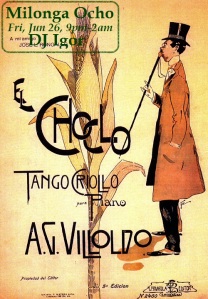 Have you ever heard Luis Armstrong played in a traditional milonga? Did he really sing tango? As a matter of fact, he did, and his “Kiss of fire” was quite a popular number, indeed: https://www.youtube.com/watch?v=ZAMpxy1EAc8
Have you ever heard Luis Armstrong played in a traditional milonga? Did he really sing tango? As a matter of fact, he did, and his “Kiss of fire” was quite a popular number, indeed: https://www.youtube.com/watch?v=ZAMpxy1EAc8
Now, how about Russian chanson? Could you recognize which tango is played here? https://www.youtube.com/watch?v=K7woFQTbu68
Well, as you have guessed, both “Kiss of Fire” and “Na Deribasovskoi otkrilasya pivnaya” (this is the name of the second tango) are remakes of “El Choclo”, one of the oldest published tango, composed by Angel Villoldo, and, probably, the most popular tango after “La Cumparsita”. So popular that at least on one occasion, and it was during the World War I, “El Choclo” was confused with the Argentinian anthem, and played where the anthem was due.
Nada más
 The best-known romance in the whole tango history, between the green-eyed beauty Ada Falcon and handsome Francisco Canaro began as long back as in 1929, and lasted for almost ten years. If you are interested in the details, there is a documentary “Yo no sé qué me han hecho tus ojos”, shot in 2003, and a whole chapter in M. Lavokah “Tango Stories” book, dedicated to this story. But we will fast-forward to September 28, 1938, the date of Ada’s last recording session with Canaro, after which their romance officially ended. The two tango she had chosen for the session were “Nada más” (Nothing more) and “No mientas” (Don’t lie). The last time Ada addressed the man she loved for a decade with those heart-breaking words:
The best-known romance in the whole tango history, between the green-eyed beauty Ada Falcon and handsome Francisco Canaro began as long back as in 1929, and lasted for almost ten years. If you are interested in the details, there is a documentary “Yo no sé qué me han hecho tus ojos”, shot in 2003, and a whole chapter in M. Lavokah “Tango Stories” book, dedicated to this story. But we will fast-forward to September 28, 1938, the date of Ada’s last recording session with Canaro, after which their romance officially ended. The two tango she had chosen for the session were “Nada más” (Nothing more) and “No mientas” (Don’t lie). The last time Ada addressed the man she loved for a decade with those heart-breaking words:
I desire nothing, nothing more
Than you not leaving me face to face with my life.
And die I will if you leave me
Because without you I won’t know how to live.
So, who were the authors of this amazing tango? I bet you would never guess…
Tierra querida
 When De Caro brothers, Julio and Francisco, formed their sexteto in 1924, and Julio proclamed “El tango también es música”, they very quickly rose to fame. Complex arrangements and harmonies, virtuoso violin of Julio, breathtaking bandoneon duo of Pedro Maffia and Pedro Laurenz (see “Tango stories: Amurado”), and firm hands of Francisco – both on the piano and on the management, just in a few months brought their sexteto into the rank of the most desired tango orquestas in Buenos Aires.
When De Caro brothers, Julio and Francisco, formed their sexteto in 1924, and Julio proclamed “El tango también es música”, they very quickly rose to fame. Complex arrangements and harmonies, virtuoso violin of Julio, breathtaking bandoneon duo of Pedro Maffia and Pedro Laurenz (see “Tango stories: Amurado”), and firm hands of Francisco – both on the piano and on the management, just in a few months brought their sexteto into the rank of the most desired tango orquestas in Buenos Aires.
In April 1927 brothers were approached by Brazilian impresario Juan Carlos Pinto with an offer to play in Rio de Janeiro. Because of the contractual obligations in Buenos Aires, Julio “politely declined” the offer, by asking an incredible amount of 2000 pesos for a single night. To everyone’s surprise, the very next morning they received the confirmation and the tickets to Rio.



